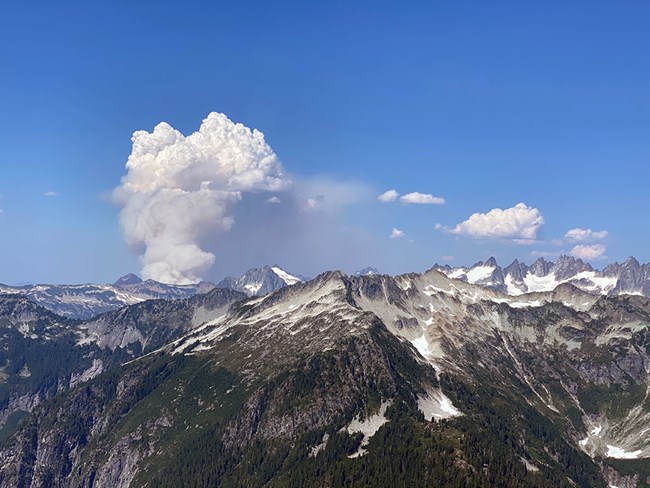Last updated: December 8, 2021
Article
The 2021 Bear Creek Fire – Suppressing Fire on the International Border

NPS/K. JONGENLEN
At the end of July 2021, the Bear Creek Fire was discovered burning in the Stephen Mather Wilderness of North Cascades National Park, WA. What made this fire different from other fires in 2021, was that it was burning approximately two air miles south of the international border with Canada in an area with no contemporary fire history. To make it more complicated, both the Northern Rockies Geographic Area, and the nation, were at Preparedness Level 5, the highest level, which meant that resources were already stretched thin across the country.
While determined to be a human-caused fire, North Cascades National Park fire management and leadership looked beyond their area and borders to collaborate further with other federal agencies and international partners on how to contain this wildfire. They considered firefighter safety, natural asset impacts from suppression tactics, current and potential threats to life and property, and how requesting resources to this fire would pull from other incidents that may need those resources more.
Fortunately, there was already the British Columbia & NW United States Wildfire Response Border Arrangement, an approved operating guideline, in place. Initially developed in May 2014, and updated over the years, this plan solidified coordination and communication in some of the most wild and rugged terrain found between both countries. Pre-COVID-19, there were face-to-face meetings every other year for a couple of days rotating between the two countries that helped to build rapport and relationships. Within the last two years, the two countries were not able to travel, but used the Microsoft Teams platform to meet virtually.
In the case of the Bear Creek Fire, from initial reporting by both countries, to sharing of models and planning areas, to public information, communication was meeting all parties’ needs. For example, smoke messaging was included for areas within Canada, specifically the Chilliwack Area because smoke was following the drainage to the north.
The Bear Creek Fire lasted nearly three months. With a final size of 1,023 acres, this interagency and intergovernmental collaboration has become normal business within this part of the country. Having the guideline in place is valuable, as it is highly likely that there will be more border fires in this area as climate change becomes more prevalent. This wildfire is a prime example of great international cooperation for the protection and preservation of our natural resources and cultural assets.
